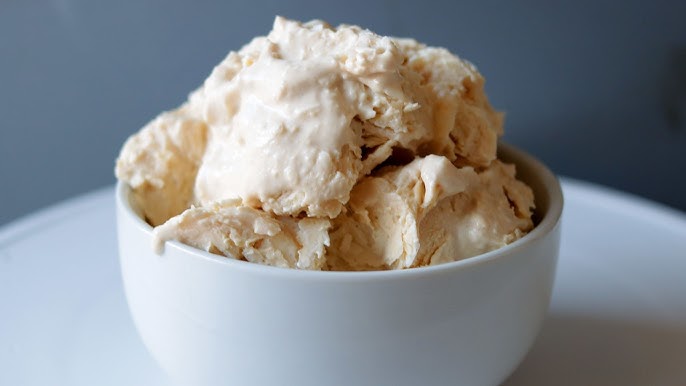Cottage Cheese Ice Cream Recipe: Cottage cheese ice cream might sound like a quirky twist on a beloved dessert, but it’s quickly becoming a favorite among health-conscious foodies. At its core, this recipe transforms humble cottage cheese into a creamy, indulgent treat—without the heavy cream and excessive sugar found in traditional ice cream. Think of it as ice cream’s healthier, gym-friendly cousin.
The beauty of this dessert is in its simplicity. You only need a handful of ingredients, most of which are probably sitting in your fridge right now. There’s no churning machine required, and the prep time is minimal. Yet, the result is a luscious, scoopable ice cream that’s rich in protein and can be customized with endless flavors.
It’s not just about satisfying your sweet tooth—it’s about doing so in a way that fuels your body. Whether you’re looking to increase your daily protein intake, reduce your sugar consumption, or simply try a creative kitchen experiment, cottage cheese ice cream ticks all the boxes.
What Makes Cottage Cheese Ice Cream Special
Cottage cheese brings a unique richness to ice cream without the heavy fat content of traditional cream. Its slightly tangy flavor blends beautifully with sweeteners and mix-ins, resulting in a balanced taste that feels decadent but light. Plus, the curds blend into a velvety base, so you won’t notice the grainy texture you might associate with cottage cheese.
Why It’s Trending in Healthy Desserts
Social media has played a huge role in its rise to fame. From TikTok food trends to Instagram reels, health influencers have showcased endless variations of this dessert. Its appeal lies in being both indulgent and nourishing—a rare combination in the dessert world.
Benefits of Using Cottage Cheese in Ice Cream
If you’ve been on the fence about trying this recipe, here’s why cottage cheese deserves a spot in your freezer-friendly creations:
High Protein Content
One of the standout benefits is protein. A single cup of cottage cheese can pack around 25 grams of protein—far more than most desserts. This makes it a great post-workout treat or a snack that keeps you full for hours.
Lower Sugar Alternative
You control the sweetness. By using natural sweeteners like honey, maple syrup, or monk fruit, you can cut down on added sugars without compromising taste. For those watching their blood sugar, this is a game-changer.
Great for Lactose-Sensitive Diets
Many brands offer lactose-free cottage cheese, making it suitable for those who struggle with regular dairy. And because cottage cheese is naturally lower in lactose, some people find they can tolerate it better than milk or cream.
Ingredients You’ll Need
Making cottage cheese ice cream is a minimalist’s dream. Here’s your base shopping list, followed by optional add-ins to get creative with.
Fresh Cottage Cheese
Choose full-fat cottage cheese for the creamiest results. Low-fat or fat-free versions will still work but may lead to a slightly icier texture.
Sweeteners – Natural & Artificial Options
- Honey or maple syrup for natural sweetness
- Stevia or monk fruit for zero-calorie sweetness
- Regular sugar if preferred
Flavor Add-ins – Fruits, Chocolate, and More
- Fresh or frozen berries
- Cocoa powder or melted dark chocolate
- Nut butters for richness
- Vanilla extract for aroma
Optional Garnishes
- Crushed nuts
- Shredded coconut
- Mini chocolate chips
Tools & Equipment Required
Unlike traditional ice cream, this recipe doesn’t demand an ice cream maker. Here’s what you’ll need:
Blender or Food Processor
A high-powered blender will give you the smoothest texture. A food processor works well too, especially for thick blends.
Mixing Bowls & Measuring Cups
Accurate measurements help you maintain the perfect flavor balance.
Freezer-Safe Containers
Use airtight containers to prevent freezer burn and maintain the ice cream’s creaminess.
Step-by-Step Guide to Making Cottage Cheese Ice Cream
Step 1 – Prepare Your Ingredients
Measure out your cottage cheese, sweetener, and flavorings. Chop any fruits or nuts you plan to add. Having everything ready makes the process smooth and quick.
Step 2 – Blend Until Smooth
Add cottage cheese, sweetener, and flavor base to your blender. Blend on high speed until completely smooth and creamy. This step is key to eliminating the curd texture.
Step 3 – Add Flavor & Sweetness
Taste the blend and adjust sweetness if needed. Fold in mix-ins like berries or chocolate chunks at this stage.
Step 4 – Freeze the Mixture
Pour the mixture into a freezer-safe container. Smooth the surface with a spatula, then cover and freeze for 2–4 hours until firm.
Step 5 – Serve & Enjoy
Scoop into bowls, garnish if desired, and serve immediately. If the ice cream becomes too hard, let it sit at room temperature for 5–10 minutes before scooping.
Creative Flavor Variations
One of the best things about cottage cheese ice cream is that it’s a blank canvas for flavor. Whether you crave fruity freshness, indulgent chocolate, or tropical vibes, you can customize it to match your mood. Here are some irresistible variations to inspire you:
Berry Blast
For a refreshing and tangy option, blend in a handful of fresh or frozen berries such as strawberries, blueberries, or raspberries. The natural sweetness and bright color will make your ice cream visually appealing and nutritionally rich. Adding a teaspoon of lemon zest can further elevate the flavor, making it taste like a gourmet dessert from a specialty café.
Chocolate Peanut Butter Delight
If you’re a chocolate lover, this one’s for you. Blend your cottage cheese with cocoa powder and a drizzle of honey or maple syrup. Then, swirl in creamy peanut butter before freezing. The result? A decadent, protein-packed dessert that tastes like a peanut butter cup in ice cream form.
Tropical Paradise
Want to feel like you’re on vacation? Add chunks of fresh pineapple, shredded coconut, and a splash of coconut milk to your blend. This version pairs beautifully with a topping of toasted almonds for a crunchy finish.
Tips for Perfect Texture
Cottage cheese ice cream can be incredibly creamy, but there are a few tricks to getting it just right:
Avoiding Ice Crystals
Ice crystals form when there’s too much water content or when the ice cream freezes too slowly. To prevent this, use full-fat cottage cheese and avoid adding excessive liquid. Freezing the mixture quickly also helps keep the texture smooth.
Achieving Creaminess without Dairy Cream
The secret lies in blending long enough for the cottage cheese to fully emulsify. Using ingredients like ripe bananas or avocado can also improve creaminess without adding cream. These additions don’t overpower the flavor but add a velvety texture.
Common Mistakes to Avoid
Even though the recipe is simple, there are a few pitfalls to watch out for:
Over-Freezing
If you leave the ice cream in the freezer for too long, it can become rock-solid. The fix? Let it soften at room temperature for a few minutes before scooping.
Adding Too Much Liquid
While it’s tempting to pour in milk, juice, or extra coconut milk for flavor, too much liquid can lead to icy, less creamy results. Stick to thicker add-ins or reduce liquid-based ingredients to maintain the right consistency.
Storing & Serving Suggestions
Making a batch of cottage cheese ice cream in advance is a great idea, but proper storage is key to keeping it delicious:
Best Storage Practices
- Store in an airtight, freezer-safe container to prevent ice buildup.
- Press a sheet of parchment paper against the surface before sealing to reduce freezer burn.
Serving Ideas for Special Occasions
- Scoop into waffle cones for a summer party.
- Serve alongside fresh fruit for a lighter dessert.
- Pair with a warm brownie for a hot-and-cold dessert combo.
Nutritional Information
One of the main appeals of cottage cheese ice cream is how nutritionally balanced it can be compared to traditional ice cream:
Calories per Serving
A standard half-cup serving made with full-fat cottage cheese, natural sweetener, and fruit can have as little as 150–200 calories.
Protein, Fats, and Carbs Breakdown
- Protein: 10–14g
- Fats: 5–8g (depending on the cottage cheese type)
- Carbs: 8–12g (varies with sweetener choice and add-ins)
This makes it a dessert you can actually enjoy guilt-free while still hitting your nutrition goals.
FAQs about Cottage Cheese Ice Cream Recipe
1. Can I make this without a blender?
Yes, but the texture may be less smooth. You can use an immersion blender or mash the cottage cheese very thoroughly by hand, though blending is best for creaminess.
2. How long does cottage cheese ice cream last in the freezer?
It can last up to 2 weeks if stored in an airtight container, but the texture is best within the first 3–5 days.
3. Can I make it vegan?
Yes! Substitute dairy cottage cheese with plant-based cottage cheese alternatives made from soy, almonds, or cashews.
4. Does it taste like regular ice cream?
It’s very close, especially if you blend it well and add flavors you enjoy. The slight tang from cottage cheese is subtle and often masked by sweeteners and mix-ins.
5. Can I add protein powder?
Absolutely. Adding a scoop of protein powder not only boosts the nutrition but can also make the texture creamier, depending on the type used.
Conclusion
The flexibility of the recipe means you can experiment endlessly — from rich chocolate swirls to tropical fruit medleys. Whether you’re looking for a quick post-workout snack, a healthier after-dinner indulgence, or a fun recipe to try with kids, this ice cream is a winner.
The best part? You don’t need fancy equipment, and the process takes minutes from start to finish (minus freezing time). So next time you crave ice cream, skip the store-bought tub and blend up your own nutrient-packed version. You’ll be amazed at how something so healthy can taste so indulgent.



